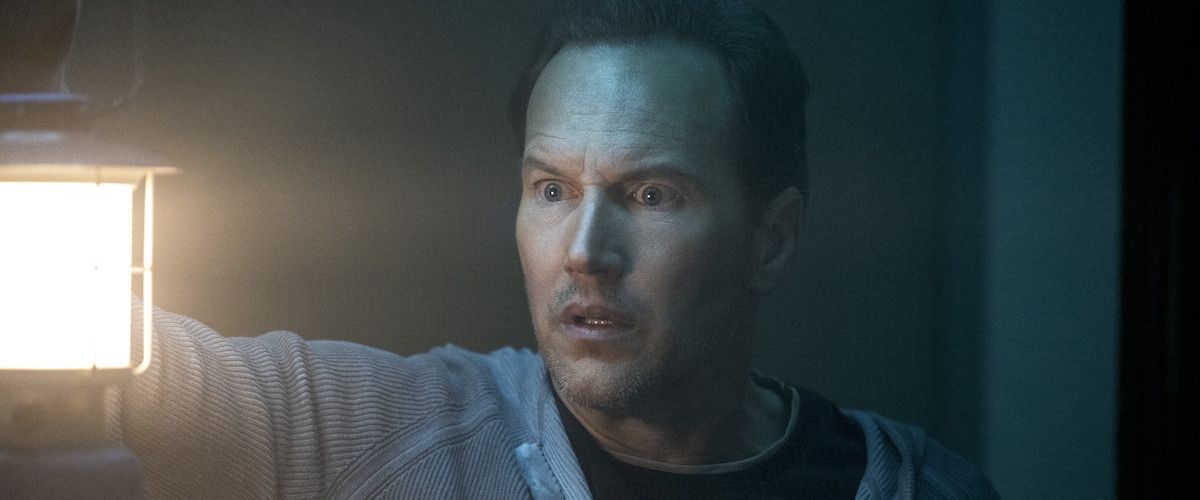Jonah Naplan July 15, 2023
In my review of Rob Savage’s disappointing “Boogeyman” adaptation, I observed that he had committed a cardinal sin by forgetting to let the audience have fun amidst all the fixings of his goofy concept. “Insidious: The Red Door,” the fifth installment in the historically lackluster horror franchise, commits another, and it’s debatably a more shameful transgression. “The Red Door” is consistently and unforgivingly boring. Nothing interesting happens. Nothing is said, done, or acted upon that makes us shriek, jump, or quiver. It’d be one thing if it had the intent to move at a slow pace, and simply blundered at keeping our attention. But Patrick Wilson’s directorial debut, running at an overlong 107 minutes, seems to have ambition, and fails so spectacularly at scaring us that we leave the theater wondering if we’ve just witnessed a bad horror movie, or an A.I.’s attempt to warn us that once we humans stop prioritizing creativity and leave art over to the robots, all hell breaks loose.
It could be both. At its best, “Insidious: The Red Door” is running on fumes, and dangerously low on good ideas. Instead of steadily ratcheting up suspense towards whatever wild conclusion the filmmakers could come up with, “The Red Door” focuses on people, and not very interesting ones, either. Josh Lambert (Patrick Wilson) is estranged from his ex-wife, Renai (Rose Byrne) and two boys, Foster and Dalton (Ty Simpkins), the latter of which is now a 19-year-old art student on the cusp of his first semester of college. After burying his beloved mother Lorraine, Josh decides to finally investigate his lingering “brain fog,” that’s lived with him for an assumedly extended period of time. An early MRI scene provides one of the film’s few moments of real terror, utilizing claustrophobia and the fear of anesthesia.
Of course, this brain fog is incurable, and is really just a side effect of Josh’s connection to the “Further” that he shares with Dalton. Via an opening scene, we understand that neither one of them recalls their first encounter with the Further, and that both of their minds were wiped clean many years ago by a hypnotist. Once this mysterious anomaly returns in force to enrapture them, they begin to see things—manifestations of dead relatives, frat boys, and demons. Yet all of these occurrences—some significant, the majority not—seem to be placed on an equal spectrum of predictability that allows the viewer to precisely time the jumpscares in their head.
The horror itself in “The Red Door” is not the movie’s weakest link. It’s the lacking of horror therein that becomes tedious and groan-inducing. Scenes of Dalton and a new friend named Chris (Sinclair Daniel) going to parties, discussing their home lives, and ruminating about the college campus itself make up about half of “The Red Door”; valuable time that could be spent elsewhere on other, more interesting things. The human drama always makes up the worst parts of any horror movie, yet this one meanders diligently on the path in which Dalton finds his creative freedom. I wish the filmmakers could have followed the same path and gained some insight along the way.
But what exactly is this “Red Door”? It’s a little unclear. In Dalton’s astral projectionist visions that allow his conscience to drift from his body, and ruminate anywhere it chooses, depictions of a blood-colored door appear in flashes. In Dalton’s art class, mentored by a blandly harsh advisor, the brooding teenager is asked to draw whatever first comes to mind with his charcoal. He draws a door; his own blood adding color to the canvas. The door itself doesn’t seem to be the symbolism, but rather the color red.
After some time, the film loses interest in putting its own pieces together, and falls subject to fan service and callbacks, leading to an underwhelming finale that never entirely communicates its themes with the oomph it aspires. The belabored tropes that “The Red Door” stretches out ad nauseam do not get any stronger the more they’re reused, and the themes of mental illness, perfected by some of the modern horror classics, feel exhausted and in need of a break.
Most importantly of all, “Insidious: The Red Door” is no fun to sit through. Chorelike and grim from scene one, it brings nothing new to the table, unlike recent demonstrations of thoughtful horror in “Evil Dead Rise” and “Scream VI.” While I’d admit it never adheres to the trope of having a character walk around a house as scary things jump out at them, it never does anything better, worse, or … anything. I’m not attempting to discourage Patrick Wilson from continuing to pursue directorial efforts, but I think there’s some synergy in me saying that I certainly wouldn’t have minded if he also gave us a good movie.
Now playing in theaters.

